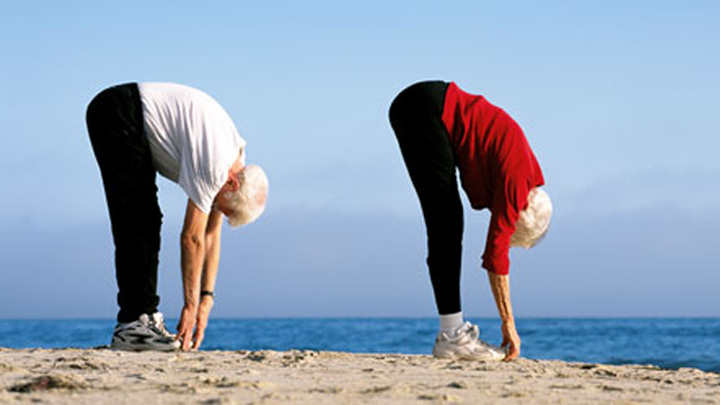
It makes me happy to hear of more people recognising and talking about the importance of core strength as a key component to good health and overall wellbeing.
Along with regular health checks, a good diet and physical activity, core strength will also contribute to you living an abundant life, being able to maintain independence and physical fitness.
Here are five ways in which you can start to improve your core strength today for future wellness:
1. Complete bodyweight exercises at home
At-home bodyweight exercises are an ideal place to start. Two that I find effective over 60s are the bodyweight squat and the bridge.
Squats work more than your legs, they work your whole body. Begin standing with your feet hip width apart, hands crossed over your chest or straight out in front of your body. Push your bottom backwards tracking your knees over your feet as low as you can go before straightening up. To stablise yourself, use a dining chair as a guide, preforming the exercise as if you were sitting down and then standing up. Repeat this 10-15 times.
To complete a bridge exercise, lay on the floor on your back, knees bent and feet flat on the floor, hip width apart. Contract your stomach and pelvic floor muscles while raising your hips towards the ceiling, lifting your bottom off the ground. When doing this exercise you should aim for a straight line between your chest and knees. Hold this for as long as you can without losing form before returning your bottom and hips to the floor. Repeat this 8-10 times. Note that if performing this exercise on the floor is too hard to manage, it can also be effective laying on your bed.
2. Play a sport
Any movement you do will require your core muscles to be ‘switched on’ to some degree – this includes many sports. Golf and swimming are two that require your core strength dial to be turned up. Swimming in particular is great as it utlises almost all of the body’s muscles at the same time. Don’t take my word for it – you would have seen how well developed a professional swimmer’s core is up on the podium at the recent Commonwealth Games! If you already engage in sport, be conscious of your posture and core muscles when moving – it could even improve your game.
3. Start a tailored clinical Pilates program
Pilates is excellent for anyone, no matter their age or gender as it is low impact exercise which puts little strain on joints. A Back In Motion physiotherapist can develop a Pilates program tailored to your body’s needs, with a focus on growing strength in all areas of your core as well as other major muscle groups. With a unique clinical Pilates program, you will not only feel but see a change in your body.
4. Practice yoga or tai chi
Back pain is often reported as a major factor affecting your lifestyle as you get older – it can be debilitating but it can also be prevented. To ensure you don’t lose your vitality to an achy back, consider regular yoga – it has been proven to have therapeutic benefits for both posture and back health.
A gentler alternative to yoga is tai chi, a form of exercise linking body and mind through low impact, slow motion movements. When combined with other treatment, the practice of tai chi has been proven to aid health issues such as arthritis, Parkinson’s disease and improve quality of sleep.
5. Be aware of your posture
Having an awareness of your posture, the way you sit, stand and move, will contribute to growing your core strength. Static posture, when still, is often easy to maintain when you remember to. Ensure your back is straight but not ridged, your shoulders are back, chin is tucked slightly and stomach muscles are engaged. It’s when most people begin to move, stepping out of the car, walking or jogging, that their dynamic posture is challenged. My tip – focus on maintaining your dynamic posture for a mini workout without needing to exert yourself through excessive movement.
For further advice or to receive a personally tailored program to improve your core strength, visit a physiotherapist at your local Back In Motion practice.
Jason T Smith is the founder of Back In Motion Health Group, Australia’s leading provider of physiotherapy and related services. Jason’s book Get Yourself Back In Motion is available at Back In Motion practices around Australia, major book retailers and online bookstores RRP $34.95. Find your nearest stockist via www.backinmotion.com.au and keep in touch with Jason via Facebook www.facebook.com/backinmotionhealthgroup and Twitter www.twitter.com/GYBIM